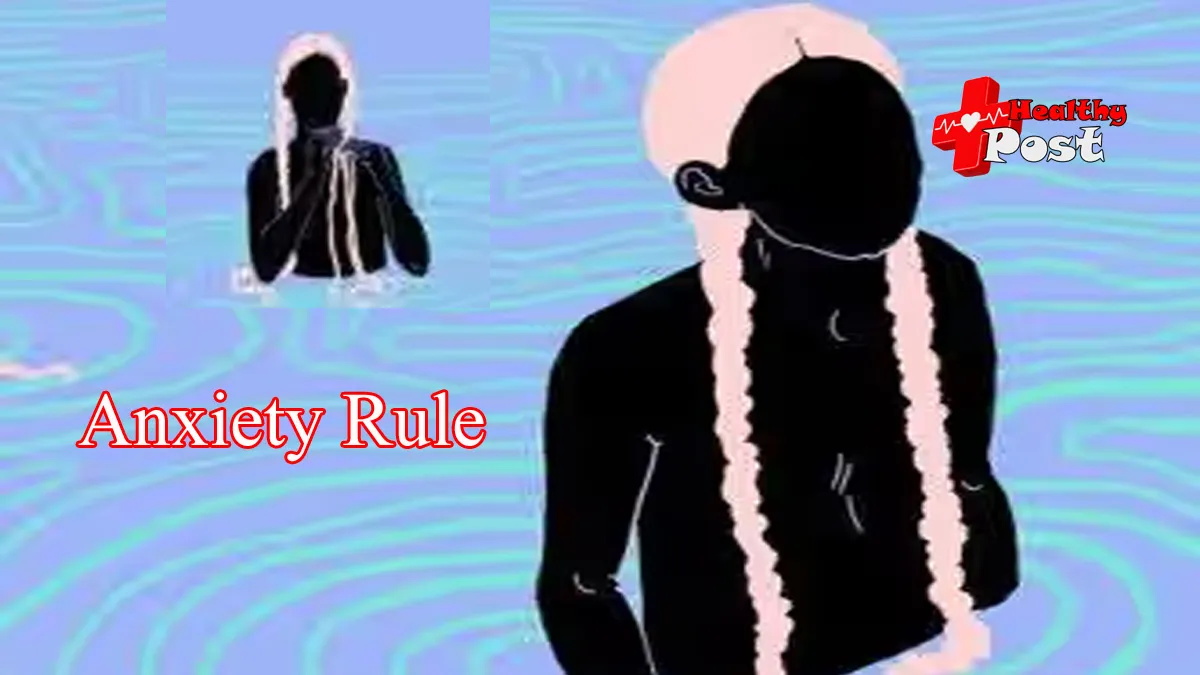
Let’s know How to Use the 3 Anxiety Rule
Most people struggle with mental health issues. Many factors can easily influence one’s thinking, from lifestyle to work, friends, family, and more. One of the most common issues is anxiety. While feeling anxious is normal, it’s still not ideal. In this article we discuss about Anxiety Rule.
Not to mention that some people struggle with anxiety attacks , which are different from your typical, short-lived feelings of anxiety. So whether you’re dealing with some anxiety or a full-blown attack, it’s always good to know how to reduce it.
Depending on your anxiety level, there are many ways to try to cope with it. Unfortunately, not all methods work for everyone. Not to mention, simple, quick tricks won’t permanently solve your anxiety. In many cases, you’ll need to find a better measure . However, if you need a quick fix, you can always try the 333 rule to reduce anxiety.
What is anxiety?
Anxiety isn’t completely unnatural. On the contrary, some anxious feelings are, unfortunately, a normal part of life . For example, when you worry or overthink, it could be because you’re feeling anxious. More simply, anxiety is an emotion that arises when you feel tense and have worrying thoughts. It can even be characterized by physical changes, such as increased blood pressure and heart rate .
But this is called a “normal” level of anxiety. It’s when you’re nervous, but you can still manage what you’re going through. There are many triggers for this emotion. Even something as mundane as taking an exam can make you anxious. Anxiety has an evolutionary purpose. Since the dawn of humanity, anxiety has been what enables us to handle dangerous situations.
If people aren’t worried about facing wild animals, they can become complacent and potentially harmed. Anxiety helps set off alarms in the body, making you acutely aware of your surroundings. Danger triggers a hormonal response in the body, releasing adrenaline . This triggers an anxiety response, known as the fight-or-flight response .
How anxiety affects you
Most of us no longer need to flee from wild animals, but there are still dangers around us that we need to avoid. For example, if a car is close to hitting you, anxiety can come in handy. But the danger doesn’t even need to be that great. Even an upcoming test can trigger feelings of anxiety.
That’s because your body is trying to prepare you and let you know you need to start working. Anxiety can even be reactive. You can motivate yourself to avoid stressful situations by simply hoping to feel less anxious. This might mean studying for an exam a few days in advance so you don’t have to learn everything the night before.
It would be wonderful if people only experienced the positive effects of anxiety, but anxiety is still a negative emotion. So, no matter how you twist it, if you want to reap the benefits, you have to pay the price. Not everyone is lucky enough to deal with only mild anxiety.
General Anxiety Disorder and Its Effects
Some people struggle with anxiety disorders, which often require therapy or medication. This condition occurs when someone deals with recurring, intrusive thoughts or worries. Because anxiety triggers physical changes in the body, anxiety disorders can have both physiological and psychological effects. Take general anxiety disorder (GAD), for example.
People struggling with GAD often feel restless or tense. They overthink and struggle to control their worries. This can lead to irritability and moodiness. High levels of adrenaline release can make it difficult for them to concentrate and sleep. But the problem doesn’t stop there. Because it’s a disorder, there are long-term effects. The psychological aspect is intuitive.
For example, people with anxiety may become pessimistic and isolated. Physically, GAD can cause heart and muscle problems and affect a person’s immune system .
Causes of anxiety
Anxiety has many causes. Mild anxiety is often triggered by environmental factors, such as stressful or traumatic events. Environmental factors can also contribute to anxiety disorders. For example, if someone grew up in an abusive household, they are likely to develop an anxiety disorder.
Genetics and brain chemistry are also risk factors for developing the disorder. If you know your family has a history of anxiety, you may want to see a psychologist to see if you might be struggling with a disorder.
Be aware that many people suffer from anxiety disorders and don’t even know it. This is largely because anxiety is natural, so people tend to think it’s no big deal. Not only that, but many people act as if others should be ashamed of struggling with anxiety. If you think you might be struggling, don’t just brush it off. It’s best to get a diagnosis, just in case. Even if you don’t have a disorder, intrusive thoughts are something you’ll experience from time to time. So, if these thoughts are so common, what can you do to ensure they’re less frequent?
The 333 Rule for Reducing Anxiety
As with all self-help techniques, the 333 Rule is by no means a substitute for therapy. Therefore, if you’re dealing with chronic anxiety, you must ensure you get the treatment you need. Depending on your anxiety, this could range from therapy to medication.
Still, a therapist can’t always be there for you. Not to mention, almost everyone deals with occasional intrusive thoughts. So, if you find yourself overthinking and worrying too much, you can learn to cope with these moments using the 333 rule. This way, you can deal with intrusive thoughts before they turn into a full-blown meltdown.
1. Focus on 3 things you can see
When you feel anxiety creeping in, you need to stop and focus on three things you can see. This is the visual part of the rule, and it can help you begin to untangle your inner clutter. It’s easy to focus on big things, like a tree or a chair. However, some people prefer to focus on small things because the details help them stay grounded. But, honestly, it doesn’t matter what you focus on.
If needed, you can always carry three objects with you that you can use. Some people even prefer this because certain objects provide them with a sense of comfort. Try to clear your mind and eliminate everything except those three items. Slowly, you’ll begin to be able to focus on everything without things blurring your mind or causing you to worry more. Once you have these objects in your field of vision, you can move on to the next step.
2. Focus on 3 things you can hear
When people feel anxious, they often become lost in the sounds around them and stop being aware of them. This is bad because it allows intrusive thoughts to grow until they become overbearing. Instead of letting your inner voice monologue , try focusing on the auditory stimuli.
This is harder than the previous step because it’s difficult to isolate sounds. For example, if you’re walking down a busy street, you might hear a thousand different sounds. Try to focus on unique noises to avoid being further confused by all of them. If they’re constant, that’s even better.
For example, focus on the sound of a car engine instead of a random horn. Something like a clock might be great for this exercise. To keep it simple, try to focus on the most obvious sound you hear and try to clear your mind. Once you have all three sounds in mind, you can move on to the last step.
3. Focus on 3 things you can touch or move
The final step in this technique is to find three things you can touch or move. Again, this helps you stay grounded and in tune with reality. These three things don’t need to be special or out of reach. If you’re sitting in a chair, you don’t need to stand up and touch something across the room. Maybe you’re on the street and can’t even see something you can easily feel or move.
In this case, you can grab something you have, like a piece of clothing. Even touching your arm can solve the problem. But again, the object you touch isn’t important; what matters is that you have an anchor that helps you focus on the physical world. This can help you relax and calm your mind. But, most importantly, it can help you lose your mind.
Final Thoughts on How to Apply the 333 Rule to Reduce Anxiety
Anxiety isn’t easy to deal with, especially if you struggle with an anxiety disorder. Even mild anxiety can still be uncomfortable and trigger destructive spirals. Intrusive thoughts, if left unmanaged, can get in the way of everything. They can ruin your day and even cause you to make poor decisions.
Sometimes, even people who’ve never struggled with anxiety can experience an unexpected panic attack. Therefore, no matter how mild or chronic your anxiety is, it’s always good to learn ways to manage it. One of the simplest and most effective techniques is the 333 rule. It’s so simple that it’s easy to remember and implement when experiencing something. As the name suggests, this technique is based on finding three things you can see, hear, and touch.
The goal is to stimulate your senses in a way that takes you out of your head. By engaging these senses, you can begin to ground yourself. Once you feel yourself returning to the real world, you can begin to relax. Be careful not to trigger the spiral again, and give yourself time before dwelling on what you’re worried about. Also, remember that if you’re struggling with an illness, this technique is a supplement to treatment, not a replacement.

4 thoughts on “Let’s know How to Use the 3 Anxiety Rule”